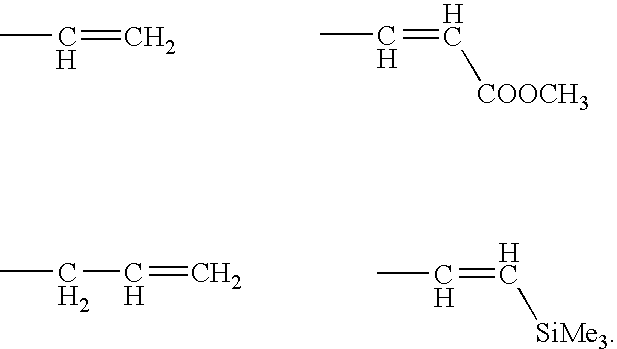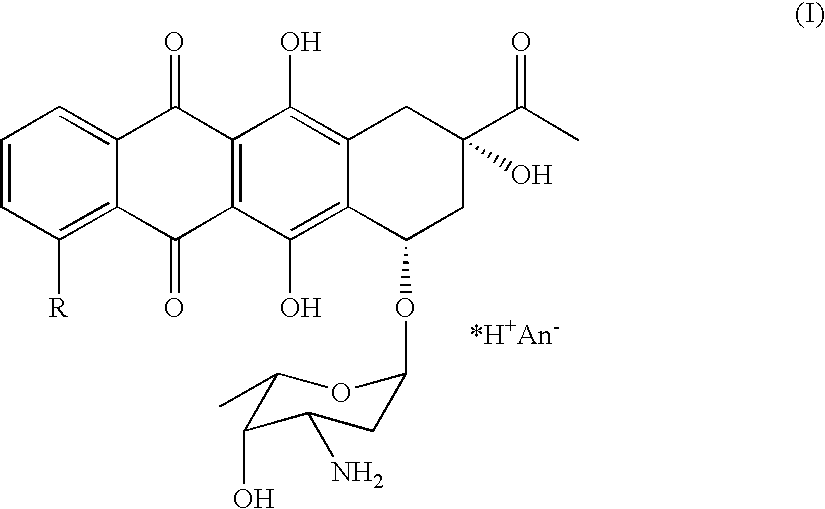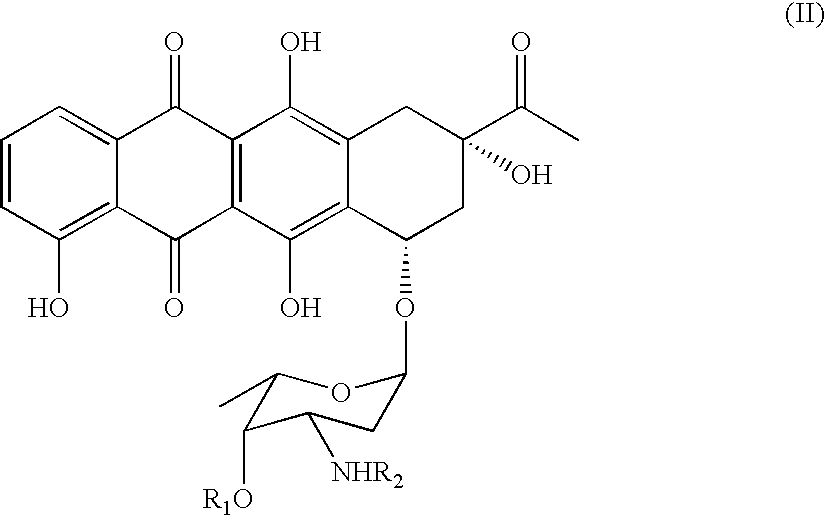Method of preparing 4-R-substituted 4-demethoxydaunorubicin
a technology of demethoxydaunorubicin and r-substituted daunorubicin, which is applied in the direction of organic chemistry, sugar derivatives, chemistry apparatus and processes, etc., can solve the problems of complicated methods of aglycone synthesis, and achieve the effect of increasing process yield and reducing the number of steps
- Summary
- Abstract
- Description
- Claims
- Application Information
AI Technical Summary
Benefits of technology
Problems solved by technology
Method used
Image
Examples
example 1
[0034]a) First, 2 g of 3′-trifluoroacetamido-4-demethyldaunorubicin (R1=H, R2=trifluoroacetyl) are dissolved in 0.2 L of pyridine.[0035]b) Next, 4 ml of diisopropylethylamine and 0.5 g of 4-dimethylaminopyridine are added to the solution of step (a) of Example 1.[0036]c) Next, the solution in step (b) of Example 1 is chilled to 0° C. and 2.5 ml of freshly distilled trifluoromethanesulfonic anhydride is added.[0037]d) Next, the solution in step (c) of Example 1 is incubated for 1 hour at room temperature.[0038]e) After incubation, 0.15 L of concentrated hydrochloric acid, 0.2 kg of ice, and 0.2 L of dichloromethane is added to the incubated solution.[0039]f) Next, the organic layer is washed in 0.2 L of distilled water and dichloromethane is removed by evaporation at partial vacuum pressure.[0040]g) After evaporation, 1.5 g of 4-trifluoromethanesulfonyl-3′-trifluoroacetamido-4-demethyldaunorubicin is produced with a purity 85% (Confirmed by HPLC).[0041]h) The 4-trifluoromethanesulfon...
example 2
[0042]a) 1.5 g of 4-trifluoromethanesulfonyl-3′-trifluoroacetamido-4-demethyldaunorubicin (R1=H, R2=trifluoroacetyl, R3=trifluoromethyl), yielded from synthesis in Example 1, is dissolved in 0.1 L of dimethylformamide.[0043]b) While stirring, 2 g of triethylamine formate and 50 mg of palladium acetate are added to the mixture of step (a) in Example 2 and an argon stream is passed through the mixture.[0044]c) The mixture of step (b) of Example 2 is then heated to 50° C. and 200 mg of 1,1′-bis(diphenylphosphino)ferrocene is added.[0045]d) The mixture of step (c) of Example 2 is heated at 50° C. for 8 hours.[0046]e) The mixture of step (d) of Example 2 is then poured into water with intense stirring with resulting sediment formation (4-demethoxy-3′-trifluoroacetamidodaunomycin).[0047]f) The sediment (4-demethoxy-3′-trifluoroacetamidodaunomycin) is filtered, and then purified by preparative chromatography.[0048]g) The yield of this process is 0.8–0.85 g of 4-demethoxy-3′-trifluoroacetam...
example 3
[0049]a) 0.85 g of 4-demethoxy-3′-trifluoroacetamidodaunomycin are added to the stirred water solution of 0.1 N NaOH (0.06 L) and incubated at 30° C. for 30 minutes. The color of the solution turns deep blue-violet.[0050]b) The reactive mixture is then poured with intense stirring into 0.5 L of 10–12% chloroform-in-butanol solution heated to 40° C.[0051]c) Next, while intensely stirring, hydrochloric acid (1:3) is added to the mixture to titrate to a pH of 8.8–9.0.[0052]d) The resulting organic layer is then washed in distilled water.[0053]e) 0.1 L of distilled water is then added to washed organic layer in step (d) of Example 3, and 0.8 N hydrochloric acid is added (0.1 L) to titrate to a pH of 3.5.[0054]f) The solution in step (e) in Example 3 is intensely stirred, and the water layer containing 4-demethoxydaunomycin hydrochloride (idarubicin) is separated.[0055]g) The solution of idarubicin hydrochloride is evaporated to 50% of its original volume and was subjected to chromatogra...
PUM
 Login to View More
Login to View More Abstract
Description
Claims
Application Information
 Login to View More
Login to View More - R&D
- Intellectual Property
- Life Sciences
- Materials
- Tech Scout
- Unparalleled Data Quality
- Higher Quality Content
- 60% Fewer Hallucinations
Browse by: Latest US Patents, China's latest patents, Technical Efficacy Thesaurus, Application Domain, Technology Topic, Popular Technical Reports.
© 2025 PatSnap. All rights reserved.Legal|Privacy policy|Modern Slavery Act Transparency Statement|Sitemap|About US| Contact US: help@patsnap.com



